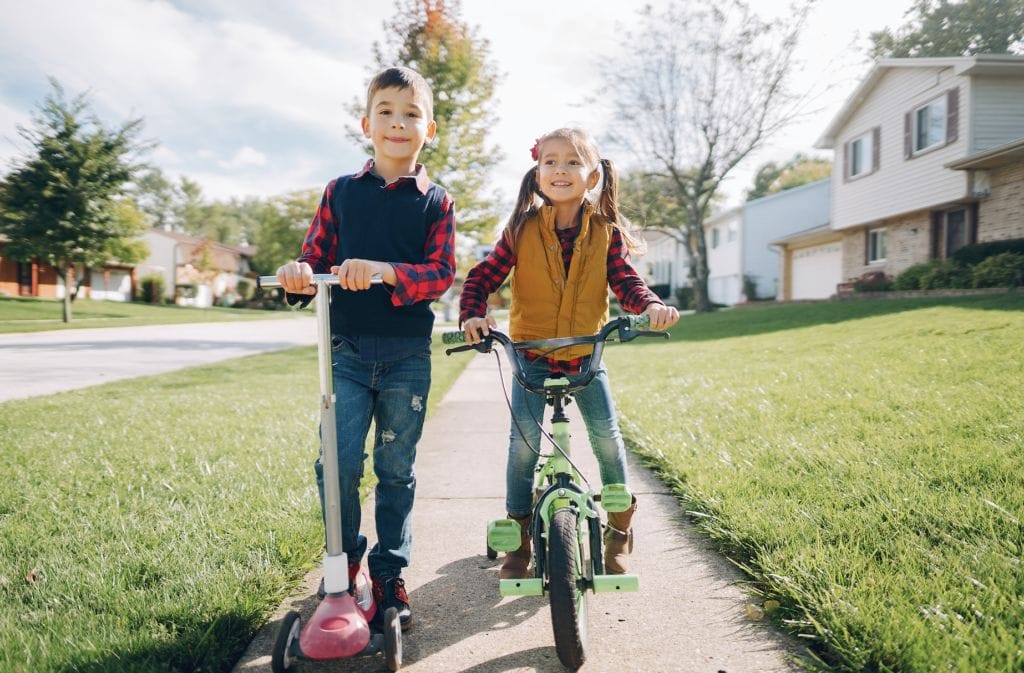
Fresh air, warm sun, crisp breeze, sandy feet, muddy hands… Ahh the great outdoors!
Angela Hanscom, the author of Balanced and Barefoot, reports that the natural outdoors makes for a perfectly balanced sensory experience. Unlike technology or man-made environments (movie theaters, sports arenas, malls), the natural outdoors tends to provide more subtle stimuli without bombarding children with too much at once (Hanscom, 2016). Unfortunately, due to most COVID-19 protocols, our children likely aren’t getting frequent enough breaks to move their bodies during the week. Therefore, it is important for us to provide them with an opportunity for active outdoor play!
In general, children can benefit from daily active free play whether it be indoors or outdoors. However, children of all ages can benefit from at least three hours of free play outdoors a day. Hanscom further broke this down by age groups in the excerpt below:
- Toddlers (12 months to 3 years) could benefit from at least 5-8 hours worth of active play a day, preferably outdoors. They will naturally be active throughout the day. As long as you provide plenty of time for free play, they will seek out the movement experiences they need in order to develop.
- Preschoolers (3-5 years) could also use 5-8 hours of activity and play outdoors every day. Preschoolers learn about life, practice being an adult, and gain important sensory and movement experiences through active play. It’s a good idea to provide them plenty of time for this.
- School age (5-13 years) children could benefit from at least 4-5 hours of physical activity and outdoor play daily. Children in elementary school need movement throughout the day in order to stay engaged and to learn in traditional school environments. They should have frequent breaks to move their body before, during, and after school hours.
- Adolescents (13-19 years) could benefit from physical activity 3-4 hours a day. Children in their teens still need to move in order to promote healthy brain and body development, regulate new emotions, and experience important social opportunities with friends out in nature.
Over the last few weeks I have asked children of different ages and backgrounds their favorite activities to do when outside. Below are some examples of their favorite activities that also provide a variety of input, interaction, and fun times!
Sports:
I grew up with my weekend routine revolving around sports, so I am a big advocate for organized sports and the benefits it has on our sensory systems and social interactions. Children learn skills like sportsmanship, coordination, agility, body awareness, and graded force just to name a few. Running and quick changes of body positioning also provides our body with vestibular input.
However, it is SO important to let our children have free play as well. Letting them lead, allowing them to create the rules and a narrative of a pretend world has so many benefits to their overall development.
Chalk:
Creating their ideal house layout, tracing themselves and adding body parts (which is great for body awareness) are great activities involving chalk. Drawing with and touching the chalk also provides them with tactile input. Sensory pathways are another great activity with chalk. By stomping, twisting, jumping, it provides children with a fun creative way to stimulate their sensory systems.
Running in the Sprinklers:
This is a great way to run around barefoot, allowing sensory feedback on the arches of our feet. According to Hanscom (2016), this gives us a good sense of where our feet are in relation to the rest of our body. If it’s too cold for the sprinklers where you live, running around barefoot on the grass while playing tag or while exploring the backyard are other activities that can provide sensory feedback to our feet.
Scooter/Bike Rides:
There are so many benefits to these two activities including working on balance skills, motor planning, while providing vestibular, proprioceptive input, and even tactile stimulation when the wind is on our face and the bright sun is shining down.
Hide & Seek:
This game allows our children to hide in nature, even if it does get them a little dirty- that is ok! It is important for children to feel different tactile sensations and tolerate some dirt on their body, especially when it is coming from their natural environment. Hiding in different positions helps work on body awareness, recognizing where your body is in space and making sure it is not easily seen to the seeker! Hiding spots like climbing up in trees allows us to practice skills such as upper body strength, body awareness, motor planning, while receiving proprioceptive input, vestibular input, and tactile input.
For additional suggestions of outdoor play activities that work on a variety of skills, please reach out to your child’s occupational therapist. In addition, I strongly recommend reading Angela Hanscom’s book Balanced and Barefoot, where she digs further into the benefits of outdoor play.
Glossary:
Body Awareness: Ability to recognize where our body is in space.
Graded Force: Ability to adjust the amount of pressure we use on an object.
Motor Planning: Ability to remember and perform steps to make a movement happen.
Proprioceptive Input: Intensive input to the muscles and joints. Helps build body awareness and grade force.
Tactile Input: Receiving information from our environment through touch. Our tactile system is also responsible for our body processing pain and temperature.
Vestibular Input: Consists of a change of position, direction, or movement of the head. It is registered through the semicircular canals in our inner ear and tells our body how it is moving through space. Our vestibular system assists with movement and balance.
References
Hanscom, A. J. (2016). Balanced and barefoot: How unrestricted outdoor play makes for strong, confident, and capable children. Oakland, CA: New Harbinger Publications.
#SpeechTherapy #TherapyMaterials #Books #LanguageDevelopment #L#freeplay #movementbreaks #outdoorplay #occupationaltherapy #sensoryintegration #activeplay #angelahanscom #balancedandbarefoot #nature #bodyawareness #balance #motorplanning #gradedforce #proprioceptiveinput #vestibularinput #tactileinput #coordination #covid
